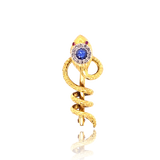Lace Jewels
18K & Platinum French Victorian Diamond & Sapphire Snake Slider-Brooch
A French Napoléon III c.1880 snake slider, that doubles up as a brooch and pendant. It is modelled in 18k gold and platinum, unmarked, but it is a typical French brooch-slider design. The body has fine engraved etchings on its body to mimic a snake's scales, giving it depth and realness.
The snake's head is set with a stunning and fiery Ceylon blue sapphire approx. 0.55ct, surrounded by a cluster of rose cut diamonds approx. 0.10ct by spread. Two rubies approx. 0.02ct rests in its eyes, giving it a slight glimmer. Total weight approx. 0.67ctw.
This particular slider is very versatile, because the opening in the snake's mouth is particularly wide, which allows for thicker width chains to be used with the snake, as well as smaller pearl necklaces or gemstone necklaces. The widest width that can go through this snake as a necklace would be around 3.5mm - 4mm in necklace width. That is a very generous and wide width that would accommodate for most chains!
Additionally, as the tail of the snake is a close loop, the brooch can be used as a pendant (worn North to South direction) as well, by threading a chain through the end of the tail as we have demonstrated in the video in this listing. It is a wonderfully versatile piece that is a fine example of French snake pieces.
It measures 35mm x 15mm, and weighs 6.28 grams.
Note: The previous stone in the snake's head was a blue iolite and it had a split down the stone. Because of the condition of the stone, we decided to change the stone to a gorgeous pale blue Ceylon sapphire with an amazing fire.
Platinum in Late Victorian Jewellery
The use of platinum is often thought to only start from the Edwardian era, but there has been documentation of platinum being used in jewellery as early as c.1880. An excerpt from Jewels of The Edwardians - Gems & Gemology - By Elise B. Misiorowski & Nancy K. Hays, Fall 1993, as seen provided by GIA in this link here.
Page 155: "After the 1880s, when major deposits were discovered ill Russia's Ural Mountains, platinum began to replace silver as the metal of choice for setting diamonds. Cartier's records show that platinum was being used in tiepins and earrings in the 1880s, and in necklaces by 1890 (Nadelhoffer, 1984). Jewelry exhibited at the Paris Universal Exhibition of 1889 used platinum as the claw settings for diamonds (Bury, 1991). Initially, platinum was simply substituted for silver in diamond or pearl mountings. Just as silver mountings had been backed with gold to protect the wearer's skin and clothing from tarnish, so platinum was also gold-backed - an equal thickness of platinum fused to an equal thickness of gold - in pieces made before 1900 (figure 3). Platinum was not initially recognized as a precious metal, so in the early years of its use the gold backing also served to give the piece credibility (Nadelhoffer, 1984). By 1900, platinum had gained acceptance, and most important jewels were made completely of platinum without the technically unnecessary gold backing."
Era - Victorian c.1880
Materials - 18k gold and platinum / Rose Cut Diamond / Sapphire / Ruby
Carat Weight - Diamond: 0.10ct / Sapphire: 0.55ct / Ruby: 0.02ct / Total weight: 0.67ctw
Measurements - 35mm x 15mm






